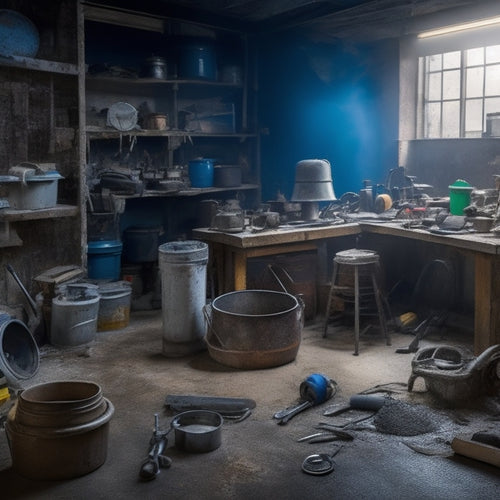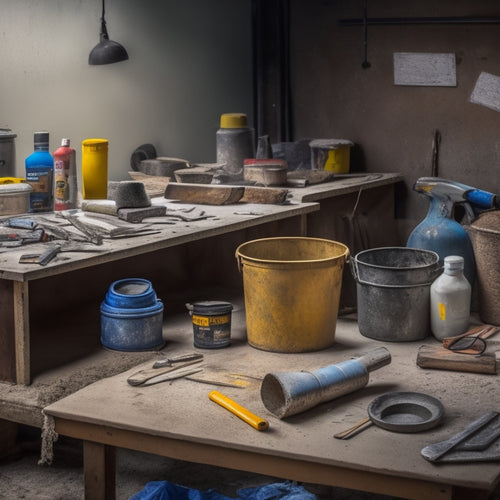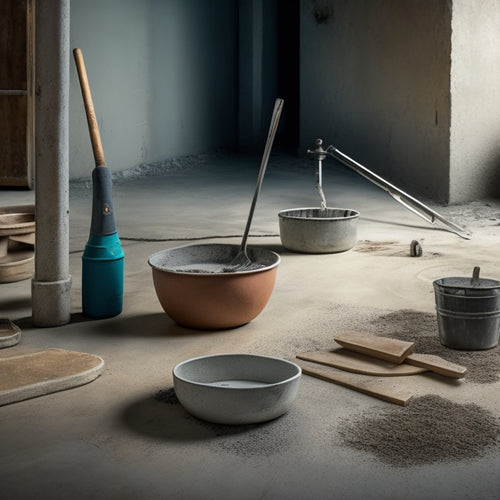
Essential Tools for Interior Concrete Projects
Share
When tackling an interior concrete project, you'll need a range of essential tools to guarantee success. Start with concrete mixing bucket essentials, such as durable materials and rust-resistant coatings, and measuring devices like laser levels and concrete test hammers for accurate measurements. Finishing tools like trowels and floats are crucial for smooth surfaces, while concrete cutting and drilling tools like diamond blade saws and core drill bits help with precise cuts. Don't forget safety equipment like protective gear and ventilation systems, as well as cleaning and maintenance tools to keep your workspace tidy. By having these tools, you'll be well on your way to a successful project - and understanding the details of each will take your work to the next level.
Key Takeaways
• Durable and rust-resistant concrete mixing buckets with measurement markings are essential for achieving accurate mixing ratios.
• Precision tools like laser levels, digital calipers, and micrometers ensure level, plumb, and properly dimensioned pours.
• Finishing tools like trowels, floats, and edgers are crucial for achieving smooth, visually stunning surfaces.
• Concrete cutting and drilling tools, including diamond blade saws and core drill bits, are necessary for precise cuts and installations.
• Safety equipment, including protective gear and ventilation systems, is vital for shielding against airborne silica dust and debris.
Concrete Mixing Bucket Essentials
When preparing for an interior concrete project, you'll rely heavily on a sturdy concrete mixing bucket that's equipped with the right features to guarantee efficient and accurate mixing.
A bucket made from durable materials such as heavy-duty polyethylene or steel is essential for withstanding the rigors of mixing and transporting concrete. Look for a bucket with a rust-resistant coating to confirm it can withstand harsh job site conditions.
The bucket's design should also facilitate effective mixing techniques. A bucket with a square or rectangular shape allows for better mixing and scraping of the sides and bottom, reducing the risk of unmixed concrete. A non-slip handle and sturdy wheels or casters make it easier to maneuver the bucket around the job site.
Additionally, consider a bucket with measurement markings to confirm accurate mixing ratios. By investing in a high-quality concrete mixing bucket, you'll be able to achieve consistent results and reduce the risk of costly mistakes.
With the right bucket, you'll be well on your way to a successful interior concrete project.
Finishing Tools for Smooth Surfaces
To achieve a smooth, even finish, you'll need to equip yourself with the right finishing tools, including trowels, floats, and edgers that are designed to work in harmony with the unique demands of interior concrete projects.
Mastering trowel techniques is vital to achieving a flawless finish. You'll need to choose the right trowel for the job, considering factors like blade material, size, and angle. For example, a steel-blade trowel is ideal for creating a high-gloss finish, while a resin-blade trowel is better suited for textured surfaces.
Floats are also essential for smoothing out the surface and removing imperfections.
Edgers, on the other hand, help you achieve crisp, clean lines and edges. When selecting edgers, consider the type of surface texture you're aiming for - will it be a rough, industrial look or a sleek, modern finish?
By combining the right finishing tools with your skills and attention to detail, you'll be able to achieve surface textures that are both visually stunning and durable.
With practice and patience, you'll develop the expertise to tackle even the most complex interior concrete projects.
Concrete Cutting and Drilling Tools
When you're working on an interior concrete project, you'll inevitably need to cut or drill into the concrete to achieve the desired result.
You'll rely on specialized tools designed for these tasks, and having the right ones in your arsenal is essential.
You'll want to familiarize yourself with diamond blade saws, core drill bits, and rotary hammer drills, which are the go-to tools for making precise cuts and holes in concrete.
Diamond Blade Saws
You'll find diamond blade saws to be an essential component in your arsenal of concrete cutting and drilling tools, as they efficiently cut through concrete, asphalt, and other hard materials with precision and control.
When it comes to choosing the right diamond blade, you'll need to take into account the type of material you're working with. There are different diamond blade types, such as segmented blades for general-purpose cutting, turbo blades for faster cutting, and continuous rim blades for finer cuts.
Regardless of the type, proper blade maintenance is vital to extend its lifespan and maintain its performance. Regularly clean the blade to remove debris and concrete residue, and store it in a dry place to prevent rust. You should also inspect the blade for wear and tear, replacing it when necessary.
Core Drill Bits
Having selected the right diamond blade for your concrete cutting task, now it's time to contemplate another essential component in your arsenal: core drill bits, designed to extract precise cores from concrete, asphalt, and other hard materials for tasks like plumbing, HVAC, and electrical installations.
You'll need to choose the right core drill type for your project, considering factors like the material you're drilling, the size of the core, and the drilling speed. There are several core drill types to choose from, including dry core drills, wet core drills, and diamond-tipped core drills, each with its own strengths and weaknesses.
When it comes to core drilling techniques, you'll want to guarantee you're using the right approach for your specific project. This might involve using a slow and steady drilling motion, applying gentle to moderate pressure, and maintaining a consistent drilling angle.
Rotary Hammer Drills
For efficient concrete cutting and drilling, rotary hammer drills are a versatile and essential tool, offering the power and precision you need to tackle a wide range of interior concrete projects.
With their advanced rotary hammer features, such as variable speed control and adjustable torque, you can effortlessly drill through concrete, brick, and block with precision and accuracy. These drills are designed to handle demanding tasks, making them perfect for anchoring, drilling, and chiseling in concrete.
To guarantee peak performance and extend the lifespan of your rotary hammer drill, regular maintenance is vital. You should always follow the manufacturer's guidelines for rotary hammer maintenance, which includes cleaning the drill regularly, lubricating moving parts, and storing it properly when not in use.
Additionally, make sure to inspect the drill's cord and plug for any signs of damage before each use. By maintaining your rotary hammer drill properly, you can ensure it continues to deliver the power and precision you need to complete your interior concrete projects efficiently and effectively.
Safety Equipment for Interior Projects
As you prepare for your interior concrete project, you'll need to prioritize safety above all else.
You'll require essential protective gear to shield yourself from hazardous materials and debris, as well as implement measures to prevent accidents and injuries.
Protective Gear Essentials
You'll need to don the right protective gear to shield yourself from the hazards inherent in interior concrete projects, including airborne silica dust, flying debris, and caustic chemicals.
To guarantee compliance with safety regulations, you must wear personal protective equipment (PPE) that meets industry standards. A vital part of your PPE is a dust mask or respirator, which filters out harmful particles from the air. Safety glasses or goggles will protect your eyes from flying debris, while gloves will shield your skin from caustic chemicals and abrasions.
Regular gear maintenance is also essential to prevent equipment failure. Inspect your PPE regularly for signs of wear and tear, and replace items as needed. Clean and store your gear properly to prevent damage and extend its lifespan.
Hazard Prevention Measures
Beyond protecting yourself with personal protective equipment, it's equally important to implement hazard prevention measures that address the unique challenges of interior concrete projects, such as confined spaces and limited ventilation.
When working indoors, you'll face hazards like dust accumulation, chemical exposure, and tripping hazards from power cords and equipment. To mitigate these risks, you'll need to identify potential hazards through hazard identification and assess their likelihood and impact through risk assessment.
You should develop a thorough safety plan that outlines procedures for emergency response, first aid, and fire prevention. Confirm that all team members understand their roles and responsibilities in executing this plan.
Additionally, designate a safety supervisor to monitor the site and enforce safety protocols. Install ventilation systems to remove dust and fumes, and use signage to alert workers to potential hazards.
Measuring and Testing Devices
Measurements and tests are critical to guaranteeing the success of an interior concrete project, and you'll need a range of devices to collect accurate data and make informed decisions.
To achieve measurement accuracy, you'll require precision tools such as laser levels, digital calipers, and micrometers. These devices enable you to take precise readings, guaranteeing that your concrete pours are level, plumb, and accurately dimensioned.
When it comes to testing methodologies, you'll need devices that can assess the concrete's strength, density, and moisture levels. Concrete test hammers, also known as Schmidt hammers, are essential for measuring the surface hardness of concrete.
You'll also need thermohygrometers to monitor temperature and humidity levels, which affect concrete curing and drying times. Additionally, consider investing in a concrete moisture meter to detect excess moisture, which can lead to flooring failures or other issues.
Cleaning and Maintenance Tools
With interior concrete projects, a clean and well-maintained workspace is crucial to preventing contamination, guaranteeing surface quality, and facilitating efficient workflow, so it is important to have the right cleaning and maintenance tools on hand. You'll need a variety of tools to keep your workspace clean and your equipment in good condition. Developing effective cleaning techniques and maintenance schedules will help you stay on track and guarantee a successful project.
Here are some essential cleaning and maintenance tools you should consider:
| Tool | Function | Frequency of Use |
|---|---|---|
| Broom and Dustpan | Sweeps away debris and dust | Daily |
| Pressure Washer | Cleans heavy dirt and grime | Weekly |
| Soft-Bristle Brush | Removes dust and dirt from equipment | Daily |
| Cleaning Solution | Sanitizes surfaces and equipment | As needed |
Frequently Asked Questions
Can I Use Exterior Concrete Tools for Interior Projects?
When it comes to interior concrete projects, you're wondering if you can reuse exterior tools.
While it's tempting to save time and money, you shouldn't assume exterior tools are compatible with interior work.
In fact, interior tool selection requires careful consideration of specific requirements, such as finish quality and dust control.
Exterior tools mightn't meet these standards, compromising your project's outcome.
It's essential to choose tools designed for interior use to guarantee a successful and high-quality finish.
How Do I Handle Concrete Spills on Finished Floors?
When concrete spills occur on finished floors, you'll want to act fast to prevent damage.
Immediately contain the spill, then neutralize it with a non-reactive absorbent like sawdust or silica.
Next, carefully sweep up the spill, taking care not to spread it further.
Finally, thoroughly clean the area with a mild detergent and water to prevent etching.
What Is the Difference Between Epoxy and Polyurethane Coatings?
When choosing a coating for your concrete project, you'll likely consider epoxy and polyurethane.
You'll find that epoxy offers advantages like high gloss, chemical resistance, and excellent adhesion.
On the other hand, polyurethane is known for its durability, flexibility, and UV resistance.
While both are suitable for interior projects, you'll need to decide which benefits matter most to you.
Will you prioritize epoxy's high-performance finish or polyurethane's long-lasting protection?
Can I Mix Concrete in Small Batches for Small Projects?
You've wondered if mixing concrete in small batches is viable for small projects. The theory is that precise control over batch sizes yields better results.
And, indeed, it's true. By mastering mixing techniques, you can achieve consistent quality even with limited quantities.
For instance, you can mix 1-2 cubic feet at a time, allowing for greater precision and minimizing waste.
This approach also enables you to fine-tune your mix design for specific project requirements.
Are There Any Eco-Friendly Concrete Options Available?
You're likely wondering if there are eco-friendly concrete options available for your project. The good news is, yes, you can opt for sustainable concrete alternatives.
Look for green alternatives made from recycled materials, such as fly ash or slag cement, which reduce the carbon footprint.
You can also explore plant-based concretes like hempcrete or mycelium-based mixes.
These options not only benefit the environment but also offer unique performance advantages, like increased durability and thermal insulation.
Conclusion
As you wrap up your interior concrete project, you've got the essentials covered.
From mixing buckets to cutting tools, safety gear to measuring devices, you've got the right arsenal to tackle the job.
But will you be able to achieve the perfect finish without the right tools? Unlikely.
With these must-haves, you'll be well on your way to a flawless, professional-looking result that will impress even the toughest critics.
Related Posts
-

7 Tools to Fix Damaged Concrete Floors
You're about to tackle that damaged concrete floor, and the right tools are essential for a successful repair. Start ...
-

3 Best Tools to Buy for Concrete Repair Online
When buying tools for concrete repair online, you'll want to research multiple retailer options to find the best prod...
-

Why You Need These Concrete Overlay Tools
When tackling a concrete overlay project, you need the right tools to achieve a flawless finish and avoid costly mist...


